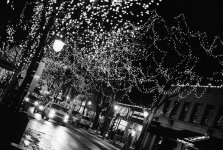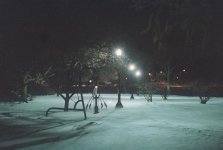With colour negative film at night, you'll have a hard job overexposing, so don't be afraid to give it as much exposure as you can.
For light trails, you obviously need to think about how long it takes for the trail to be as long as you want it to be and give it enough exposure. Don't be afraid to overexpose by many stops, even if your meter says '1 second at f/8' don't be afraid to give it 8 seconds, that's only 3 stops overexposure, easy for a modern colour negative film like Portra 400.
Honestly, I've done better listening to my gut than my meter at night.
For cafes etc. I'd just open up the lens to f/2 or as fast as you can go without compromising your desired DOF too much, and use as slow a shutter speed as you feel you can hold steady. With a modern 400 or 800 speed colour film, that should probably be OK.
Perhaps my advice isn't the technical advice you're after, but I've found that the darker it gets, the more unreliable my meter's advice becomes.







